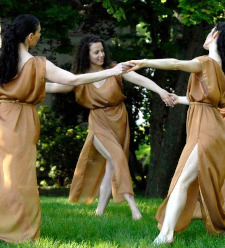
Barney Yates
RECREATING CLASSICS OF MODERN DANCE WITH "THE WELL"
"The Well," a presentation of Loretta Thomas' Moving Visions Inc., took stage at Mark O'Donnell Theater at Actors Fund Arts Center October 22 to 24, 2021. It was a collection of 20 dances recreated from their Modern Dance origins in the early 20th Century. I was eager to attend, having thoroughly enjoyed another "historical" program, "Denishawn: Dances of Ruth St. Denis & Ted Shawn," which was presented at The Theatre at St. Jeans at the beginning of the month. "The Well," as it happens, offered a reprise of one part of that evening: "Choeur Danse" (1926), choreographed by Ted Shawn, staged by Francesca Todesco. The evening was named for "The Well," a piece choreographed by Loretta Thomas, which was in the style of the historic pieces but by far the most conceptually elaborate part of the program. It concluded the evening. Ms. Thomas was listed as choreographer of "Saudades," set to music of Darius Milhaud and Saudades des Brazil, which opened the evening, and"Everyman's Reroof," a new work set to Vivaldi which was the first piece to greet us after intermission. The program contained at least five dances set to Waltzes and four to Mazurkas. Five dances were choreographed by Isadora Duncan herself, notable among them being "Mother" (c. 1921), a work set to Scriabin that depicts a mother grieving and bidding farewell to a departed child. Danced by Loretta Thomas, it had the resonance of deep understanding. Grecian imagery was notable in the aformentioned "Choeur Danse (c. 1926), a work by Ted Shawn in which figures from a Grecian vase come to life in the sunlight, and "Three Graces," which was set to a Schubert waltz. The program credits a passel of artists, both veterans and "early career" dancers, whom I recount here: "Moving Visions Dancers," led by Loretta Thomas, including Abra Cohen, Jessie King, Holly Mitchell and Corinne Shearer; guest artists Catherine Galllant and Amelia Dawe-Sanders; "Dancers we Dance," led by Francesco Todesco, including Kathleen Caragine, Colleen Edwards, Rosy Gentle and Margherita Tisato. Pianist was Candace Chien. Set was by Anne Patterson; costumes were by Ivana Drazic and lighting was by Joshua Davenport. I want to praise all of these artists for undertaking the practice of conservatorship and for offering audiences these faithful reproductions of classic dances. The study of classical dance forms is a gateway to the practice of what we now call Modern Dance, not only in the sense of the Duncanesque genre we call by that name, but also with respect to nearly all the disparate genres that we enjoy today. It is interdisciplinary by nature, involving the study of some of the greatest and most influential forms of performance and art, along with 20th century history and the study of social issues such as gender roles and sexuality. It even goes into societal reactions to modern warfare and emerging philosophies and psychoanalysis. Artists who study these modern classics are motivated by the desire to understand their cultures and also find that this study leads to an examination of questions that are relevant to all human cultures -- the nature and limits of human nature, the purpose and scope of social and political organizations, the place of literature and myth in civilization, and so on. Thanks to work like this, our understanding of Dance, and indeed all modern performance, can have a ballast it would not have without it. [BY]
|
| museums | NYTW mail | recordings | coupons | publications | classified |

